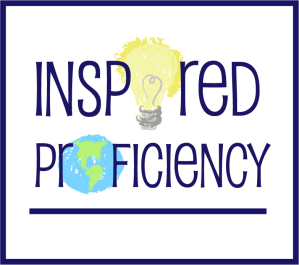Show notes for season 3 are written and compiled by Emily Loughlin
Welcome to Inspired Proficiency and thank you for joining us for the first episode of season 3. Thank you to our presenting sponsor Wayside Publishing! As always, please tweet any takeaways and inspirations using #inspiredproficiency.
Click here to download audio or listen on Apple Podcasts, Stitcher, Google Play and other podcast players.

Welcome back to Inspired Proficiency and thank you for joining us on our journey into season 3. As always, please tweet any takeaways and inspirations to #inspiredproficiency.
On the first episode Ashley talks about high leverage teaching practices with Rebecca Blouwolff, the NECTFL 2019 teacher of the year. Rebecca teaches 7th and 8th grade French at Wellesley Middle School, a suburb of Boston, MA.
 Rebecca walks Ashley through one of two high leverage teaching practices she recently presented at the NECTFL conference in New York City. These practices talk more about how to teach and not what to teach. Her ideas come from reading the book Enacting the Work of Language Instruction: High Leverage Teaching Practices by Glisan & Donato. Rebecca describes the importance of watching, doing, and experiencing training to get better at what you’re doing and how it important is for teachers to participate when trying new teaching practices.
Rebecca walks Ashley through one of two high leverage teaching practices she recently presented at the NECTFL conference in New York City. These practices talk more about how to teach and not what to teach. Her ideas come from reading the book Enacting the Work of Language Instruction: High Leverage Teaching Practices by Glisan & Donato. Rebecca describes the importance of watching, doing, and experiencing training to get better at what you’re doing and how it important is for teachers to participate when trying new teaching practices.
Big takeaway from the first high leverage teaching practice: Using the Target Language (TL) in class with the kids is the most important thing you can do. We are privileged to be able to provide that environment for our students and get to know them through the language.
Facilitating Target Language Comprehensibility
ACTFL’s recommendation is 90% PLUS target language use in the classroom
More and more people are curious as to HOW to make this happen and are you REALLY able to accomplish this. This is still a struggle for many teachers as well as students so trainings are still needed. This is the industry standard but it’s not how most of us learned so we need to shift our mindsets to this new idea. We need to stay in the language but make it comprehensible and digestible for our students.
HOW to make TL comprehensible?
- Paraphrase new words
-
-
- Dance around the words if you don’t know them or students don’t know them yet and model circumlocution for the students.
- It’s worth taking the time to stay in the target language.
-
- Define by examples
-
-
- Using examples of real world places like a bakery, use a local bakery instead of reverting to English automatically.
- Non examples of what it is NOT are also helpful to students if that is quicker than explaining other examples.
-
- Go slow
-
-
- Upon transition from textbook to thematic unit the amount of core vocab words will shrink because they will acquire them and not just study them for the unit.
- Build upon what students already know and use that as a base for where you can start when adding new material builds greater understanding of new vocabulary. (recycle)
-
- Signal new words with tone of voice
- Make it known to your students with your tone of voice to signal something new is being introduced or focused on.
- Use connected discourse
-
- There’s no connection and meaning when students just repeat the vocabulary after the teacher.
- If students and teacher draw the house and the rooms of the house together then there are opportunities to elaborate and connect it to prior knowledge as well as anticipate what’s happening next. Students see how the individual pieces become part of the whole in a meaningful and comprehensible way.
HOW to make understanding visible?
-
-
- An important part of the lesson plan is to create some non-verbal learning checks to see if students are understanding what you’re doing in class. Some formative non-verbal tasks to show visible understanding include matching tasks and manipulatives or card sorting activities. This is also possible with TPR (Total Physical Response) but some ideas can bemore private or just with a partner.
- Shelby County Public Schools in TN has created cards (hold ups) to go along with the Total Participation Techniques book for many different languages to do exactly this. Students hold up cards to answer questions in the TL to identify and make understanding visible.
- Total Participation Techniques
- Language Specific Hold Ups
- Tips for comprehensible interactions
- Be thoughtful and intentional about the order that questions are asked of the students.
- Start with yes/no.
- Move on to who, what, where, when, why.
- Advance to more open ended and what they can produce.
- Would be really beneficial to script the questions for a lesson once in a while or practice with a colleague and use more in the classroom.
- Be thoughtful and intentional about the order that questions are asked of the students.
- Advice for teachers seeking target language comprehensibility
- Topics and objectives and/or purpose are explicitly communicated for the learners
- Gestures are powerful but words are also important to make sure language is acquired behind the gesture
- Planning for making understanding visible ideas but give yourself a break if you can’t make manipulatives all the time and if the students can help create it on the spot use them to help you
- Know where your 10% English is and be consistent and hold yourself accountable
- Advice for teachers to avoid
- Repeating after the teacher has no place in the world language classroom
- Translation can teach the kids to just wait for you to translate and cheats them out of the circumlocution opportunity
- Gestures are helpful but if students aren’t acquiring in a meaningful interaction then those words aren’t going to stick
-
For the variety segment, Profe Ashley also plays a fun trivia game with Pamela Russell (@pammycakes_87) and Melanie Thomas (@senoraMThomas). She asks questions about the first two seasons of Inspired Proficiency. Thanks to Pamela and Melanie for playing and thanks to everyone who helped support this podcast into its third season!
Resources and links mentioned on the show:
Guests:
- Rebecca Blouwolff
- Twitter @MmeBlouwolff
- Blog https://mmeblouwolff.weebly.com
Books:
- Enacting the Work of Language Instruction: High Leverage Teaching Practices by Glisan & Donato
- TotalParticipation Techniques by Himmele & Himmele
Other resources:
- Rebecca’s blog post on her 6 hour session on High Leverage Teaching Practices with Dr. Catherine Ritz (on Twitter @ritzforeignlang)
- Their slides
- Greg Duncan’s TELL project article “Engaging Language Learners” with references to Total Participation Techniques book
- Shelby County Public Schools
- Total Participation Techniques Resources from Shelby County Public Schools
- Language Specific Hold Ups in many languages from Shelby County Public Schools
Episode sponsors:



Pingback: Brillante Viernes: March 15, 2019 – Maris Hawkins